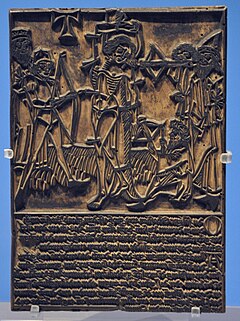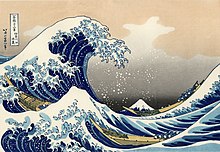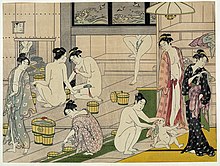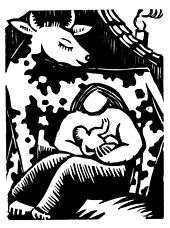Woodcut
The timber section is a high-pressure process , in which a relief-like wooden printing block is used to graphics to produce; The individual graphic created in this way is also called a woodcut. Like wood engraving and block printing , the woodcut is one of the xylographic processes . Since the invention of the printing press , the woodcut has been the most suitable method for illustrating books, as the printing block could be inserted into the typographical set and printed with it in one operation.
Woodcuts in which different woodcut plates are used for different colors and thus several colors can be seen on the finished print are called color woodcuts .
To produce the printing block, the non-printing parts are removed from a smoothly planed wooden board with cutting knives and the raised parts are then colored and printed ( high pressure ). The impression is performed by means of a Handabreibung Falzbeins or by a printing press.
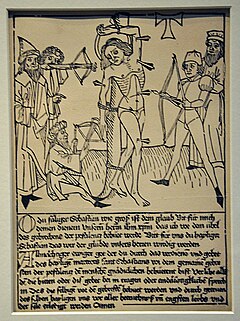
Manufacturing process in detail
Production of the printing block
As a rule, a block of wood is cut in such a way that a panel about two to four centimeters thick is created, the fibers of which run in the direction of the picture surface (long cut). It is carefully planed, sanded and smoothed until the completely flat surface can be coated with a primer, usually a thin layer of white chalk. The artist usually applies the preliminary drawing to this layer of chalk and then uses various knives to cut the pre-drawn lines very precisely. This is not done with a vertical cut, but with two cuts, one inclined away from the recorded line and one counter-inclined (cut and counter-cut), whereby a piece of wood can then be removed. At the end of this process, the lines and surfaces of the drawing remain as ridges, ridges or islands. In this so-called black line cut , the figuration is formed by black lines on a white background.
The finished printing block is finally colored with printing ink , which is done by pressing on a fist-sized, soaked ball or, more often, by rolling over it with a roller.
The designation signed in the stick means: The artist's signature is in the printing block of the woodcut .
The pressure
The printing is done by pressing the wooden plate onto unsized paper - either thick handmade paper or thin rice paper - (or vice versa), which then absorbs the color. With rubbing pressure , this is done by rubbing the applied paper with the ball of the hand; when brush pressure of a brush, the necessary close link between paper and the paper by the coating pressure Stock effected. Most often, however, the proof is produced with a letterpress press, which applies moderate vertical pressure to the horizontal plate with the paper on top.
The plate is re-colored after each printing process. Since toggle presses, which used to be preferred for printing woodcuts, are no longer manufactured and are hardly available anymore, roller presses (gravure presses) are often used. A guide rail or a larger cover plate over the printing block and paper can anticipate the rocking of the roller press. High volume woodcuts are often printed on letterpress presses.
Woodcuts are sometimes transferred onto the stone and peeled off like a lithograph . It is then a lithograph based on a woodcut, i.e. an "original graphic " reproduction (see also graphic ).

Types of wood used
Almost all types of useful wood are suitable for wood cutting. One of the few types of wood that can hardly be used for woodcut is that of the common pine , as the wood is too inhomogeneous, occasionally knotty and too resinous.
The wood used is usually cut along the grain as so-called long wood. Hardwoods such as pear, nut or cherry are particularly popular for more detailed graphics, as they can be cut more evenly than softwood and therefore fine lines can also be achieved. Softwoods are particularly suitable for large-scale work and have the additional advantage that large panels or boards are cheaper to buy than those made of hardwood.
Chipboard, veneer and blockboard or plywood, so-called panel material, are also used. These wooden forms are popular with printmakers because they do not warp and larger formats are also inexpensive. Occasionally, old furniture wood is even used for the woodcut.
The grain or structure of a wood is occasionally used deliberately as a graphic element. Weathered wooden boards are particularly suitable for this, the grain of which is highlighted in relief, as the softer layers have already been eroded by weathering. This effect can also be created artificially by treating the wooden board with a wire brush or by etching the surface with diluted nitric acid .
While with most woodcut techniques the choice of wood is essentially an artistic decision, with wood engraving it is necessary that the wood used has a fine, tight grain. The cross-sectional fiber for prefers end grain of the book tree , which however is very expensive due to the slow growth of this plant. With old printing blocks made of boxwood, the underside of the plate is therefore also used or the upper side is planed off so that it can be re-engraved.
Tools
The basic equipment of a wood cutter includes:
- the grave stylus , with which straight and parallel lines are engraved in wood
- the goat's foot , which cuts a V-shaped groove
- the round graver or the round iron
- the gouge , with which larger, non-printing areas are cut away. Some wood cutters only work with smaller and larger gouges and do without tools such as contour knives
- Contour knives that are used to cut fine lines
All woodcut tools have a different cutting effect due to their different cutting edges and profiles. As a rule, with the exception of the contour knife, they have a mushroom-shaped handle. This is to help put more pressure on the tool. Nowadays, more modern tools like milling machines are also used. HAP Grieshaber even used chainsaws for its very large woodcuts.
Features of manual woodcut
An artistic woodcut graphic has specific characteristics that clearly distinguish it from prints made with other techniques such as copperplate engraving or mezzotint :

- The back of the print shows a slight embossing that can usually be clearly felt. The line bridges are lightly pressed into the paper, which distinguishes the woodcut from all flat prints.
- When pulling by hand, the back of the paper becomes slightly shiny (rubbing marks). Friction pressure is time consuming; however, it gives the artist the opportunity to influence the end result through the way in which the printing block is colored and through the rubbing. However, this means that the differences between individual prints are greater than is the case when printing with a printing press.
- Due to the relatively low expenditure of force with which the impression is made from a wooden stick, the print does not show a pinch or plate edge, which makes it different from any gravure .
- The color of the lines is equally dense on the entire sheet, since the printing ink is the same on each printing part.
The quality of the print - an essential decision criterion for the potential buyer of an artistic printmaking - depends on the cleanliness and sharpness of the print. The prints must not have strong squeezed edges. Prints that are too bold in color smear subtleties and leave a brown halo around the black bars and fields. These "smelly" prints are of poor quality.
Variants of the woodcut technique
The classic techniques of woodcut are:
- Black line section , in which the raised and thus printing parts of the printing block reproduce the drawing. The black line cut is the most original form of the woodcut.
- White line cut , in which the lines of the drawing are cut into the wood block like an engraving. When printing, the area that actually makes up the background is printed out, and the representation results - not in printing - from the white lines. The white line cut was mainly used in the 16th century. Albrecht Dürer used it with its negative inversion to increase the artistic effect in black-lined woodcuts.
- Surface section , which was mainly used by French artists of the 19th century. The drawing was usually cut negatively on a large board. Paul Gauguin preferred to use raw crate boards to use the roughness and grain of the wood for artistic expression.
- Wood engraving (xylography), in which a wooden plate cut across the grain is processed with a copper engraving grave instead of a knife. With this, a larger semitone gradation can be artistically achieved. The wood engraving is to be classified as a technical advancement of the woodcut.
- Grisaille woodcut , the motif is transferred to a plate, the main printing plate. This is colored with black printing ink. The black and white print is completed by the print of one to four plates that are printed in different gray tones. The result is the so-called grisaille woodcuts. In 1940, Torsten Billman made attempts to print the woodcut with multiple plates and this became his special technique.
With white printing, the raised areas of the printing plate are painted with white paint and drawn off on black paper. For multi-color printing (color woodcut) , the printing is carried out with several plates or the technique of the Clair-obscur woodcut , the Camaieu cut , the dismantling cut or the puzzle printing is used. Modern wood cutters combine all of these processes.
historical overview
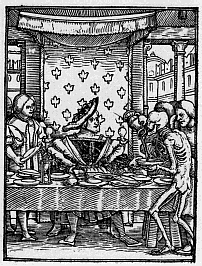
origin
The technique of letterpress printing, which is very simple in principle, is one of the oldest methods of mankind to record images. Of these, printing with cut wooden clichés is the oldest graphic printing process. Babylonians and Egyptians had already printed cut wooden stamps in a soft tone, and in the 4th century the Chinese Empire even knew the possibility of coloring relief-like inscription stones with ink and rubbing them on paper that had been made there since the 1st century. The woodcut is therefore not an actual invention, but only the application of long-known technical possibilities on a material that was previously little used.
Single sheet woodcut and early book production
The basis for the artistic flowering of woodcuts in Europe was the establishment of an efficient paper industry in Europe from around 1400. The earliest artistic woodcuts were created as so-called single - leaf woodcuts between 1400 and 1550, first in Alpine and Bavarian monasteries. As “ plague leaves ”, for example, they depicted the saints who were venerated as plague helpers , also gave prayer texts and finally also contained medical advice on preventing the plague . In the form of leaflets and pamphlets, the woodcut also served as a mediator of religious, ideological and artistic ideas, especially during the Reformation. The first woodcuts bearing the artist's name were made around 1465 by the master Ulrich Feierabend in Rapperswil. In addition to single-sheet prints, so-called block books have also been produced using wooden board printing since 1430 . With the expansion of efficient book printing plants, the Polish woodblock art began around 1473, the center of which was in the university city of Krakow. The use of woodcuts for book illustrations increased with the advancement of book printing by Johannes Gutenberg . The invention of letterpress printing by Gutenberg with movable type (around 1440/65) changed the way text was reproduced and increased the desire for an equally high-circulation illustration. The “ Schedelsche Weltchronik ” from Nuremberg printer Anton Koberger from 1493 contained almost 2,000 woodcuts. For the production of this plant, Koberger employed up to 100 journeymen on 24 printing presses.
See also: Accipiesholzschnitt , Wandereisen-Holzschnitte from 1523
The woodcut between renaissance and industrialization
The woodcut reached its first artistic peak in the Renaissance , when artists like Albrecht Dürer and Hans Baldung created masterpieces of this art form. Dürer in particular freed the woodcut from its predominant function as a book illustration and redefined it as an independent medium of a work of art. Formally, Dürer brought the woodcut close to the copper engraving by creating a rich scale between dark and light.
The first attempts at overprinting differently colored plates were made during this period, after only prints of single-leaf woodcuts had previously been colored by hand. With real color printing, each color is given its own printing plate, but the technical difficulty with this process is that the printing process cannot be precisely controlled due to the shrinkage of the moistened and re-drying paper. The first colored wood prints can be dated to 1486, Lucas Cranach the Elder and Albrecht Altdorfer undertook further attempts ; the latter succeeded in a multi-color print of six blocks in 1519/1520. After Altdorfer's work, there was no intensive discussion of color printing in Germany for the time being, which may be due to the increasing spread of Albrecht Dürer's black and white graphics .
The xylographic reproduction processes were dependent on the individual skills of the shape cutters and wood carvers . The inventions in the field of image reproduction using opto-chemical reproduction processes as well as the invention of photography and the autotype in the second half of the 19th century meant that from this point on the woodcut became meaningless for industrial book and magazine production and only in the artistic Area was used.
The woodcut in China and Japan

Independent of the development of the woodcut in the western world, the use of this printmaking technique developed in the East Asian region. The oldest surviving woodcut is an illustrated version of the Diamond Sutra from the year 868. It experienced its first climax in the Song period (960–1279) in China, when artists began to join forces in wood carving workshops. Great technical perfection was developed in the production of multicolored woodcuts. For the implementation of artistic ideas, however, other techniques were preferred: In the 17th century, woodcuts in China were only used to reproduce pictures, whereby efforts were made to reproduce the effect of a brushstroke and the gradation of ink as accurately as possible.
As a separate art form, however, the woodcut developed in Japan, where the technique had come from China towards the end of the 8th century. It reached its peak between the 17th and 19th centuries. In the beginning, the Japanese woodcuts were votive pictures , which were mainly created in the woodcut workshops of Buddhist monasteries. These votive pictures thus had a similar function to the single-leaf woodcuts in Europe in the 15th century.
At the beginning of the 17th century, Japanese woodcut artists turned to secular subjects. The artists united in the so-called plebeian schools in Edo , Kyōto and Osaka created illustrations of classical and popular literature as well as free graphic sheets. Initially only printed in one color, the Japanese color woodcut developed in the mid-18th century .
The Japanese woodcut was produced by a draftsman, wood cutter and printer. Up to 12 panels and more were cut for colored woodcuts, which required extremely precise work. The subjects of the woodcut were predominantly scenes from the kabuki , portraits of actors and women ( bijinga ), there were also depictions of famous places, historical scenes, sumo wrestlers, landscape and nature images and shunga , prints of an explicitly sexual character. Well-known representatives of Japanese woodblock prints were Nishikawa Sukenobu , Suzuki Harunobu , Kitagawa Utamaro , Katsushika Hokusai and Utagawa Hiroshige .
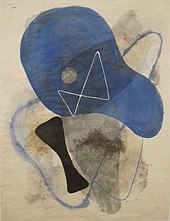
At the end of the 19th century, the Japanese woodcut initially lost some of its artistic importance. Woodcuts were increasingly used for other purposes such as reporting, educational and educational work and did not require any special design. Artists such as Toyohara Kunichika , Toyohara Chikanobu , Kawanabe Kyōsai, and Tsukioka Yoshitoshi maintained the traditions of woodblock printing during the Meiji period . The latter two succeeded in integrating new, western elements into their style in the last decades of the 19th century and thus working together with other, independent artists such as B. Kobayashi Kiyochika and Ogata Gekko pioneers of the new art movements Shin hanga and Sōsaku hanga .
The Shin hanga movement (literally: new print) introduced moderate technical innovations, but otherwise retained both traditional production and traditional motifs. In the first half of the 20th century, Shin hanga woodcuts were particularly successful abroad, where there was great interest in traditional Japanese motifs. The driving force behind the Shin hanga movement was the publisher Watanabe Shōzaburō (1885–1962) and one of its best-known artists (draftsmen) was Kawase Hasui .
The Sōsaku hanga movement (literally creative pressure), on the other hand, broke with traditional designs and motifs. One of their trademarks were the principles of jiga (self-drawn), jikoku (self-carved) and jizuri (self-printed), so the artist carried out all 3 work steps for the production of a woodcut (drawing, carving of the printing block, printing) himself. The movement achieved its international breakthrough in 1951 at the São Paulo Biennale . Her well-known representatives include Saitō Kiyoshi (1907–1997), Onchi Kōshirō (1891–1955), Hiratsuka Un'ichi (1895–1997), Watanabe Sadao (1913–1996), Maki Haku (1924–2000), Munakata Shikō (1903–1975) and Naoko Matsubara (* 1937).
The influence of the Japanese woodblock print in Europe
The Japanese colored woodcut with its bright, watercolor-like printing inks became a popular collector's item in Europe in the 19th century and thus forms an essential part of Japonism . The simplicity and expressiveness of these works inspired western artists to focus on woodblock prints . One of the first rediscoverers was the British illustrator William Morris . After 1870, the French Impressionists , including Paul Gauguin, experimented with woodcuts first. They often used the composition of the classic Japanese woodblock print without a center point, which invites the viewer to let his gaze wander over the picture surface. Often there are also unusual angles and figures cut off at the edge of the picture on the prints.
Expressionists such as Erich Heckel , Ernst Ludwig Kirchner , Max Pechstein , Edvard Munch , Frans Masereel , Emil Nolde , Max Thalmann and the Swiss Carl Eugen Keel valued the woodcut because of its austere and powerful expression, but also artists of the New Objectivity such as Georg Schrimpf and his friends Ms. Maria Uhden took on the technology. In addition, Ernst Barlach , Otto Pankok and Käthe Kollwitz , whose art is located between realism and expressionism, have made particular contributions to the woodcut in art . Cyrus Overbeck stands in this tradition, as a narrative realist of the present, combining woodcuts with other artistic techniques such as spraying , screen printing and painting .
In the first half of the 20th century, the color woodcut was often used to illustrate children's books, for example by Alfred Zacharias .
With the advance of abstract art, interest in woodcut declined again. Today it is only used occasionally to convert an artistic idea into a print graphic. In the second half of the 20th century, alongside Hans Arp , Heiner Bauschert and František Kupka, it was above all HAP Grieshaber who ensured the continued appreciation of woodcuts as an artistic medium - he almost exclusively produced woodcuts, the effect of which was often stronger through play Lines and white surfaces are created with a high degree of abstraction of the depicted. Another well-known modern wood cutter is the Swiss Martin Thönen . The most famous wood cutters are members of XYLON , the international association of wood cutters.
Photo oxylography
As Fotoxylografie is called a woodcut process in which the object is to be reproduced photographically transferred to the prepared wooden floor. For this purpose, the wooden stick was originally covered with a layer of chrome gelatine and the picture was copied on it. At the end of the 19th century, this technology was replaced by the silver nitrate process . A few drops of thick protein were mixed with a little ammonia and applied to the wooden stick. This layer was dusted with finely powdered and well dry egg white. The dusted layer was finely exaggerated and polished until the surface was almost completely dry. It was prepared by pouring a solution of silver nitrate (1: 8) over it, wiping off the excess and, after drying, exposing the plate to ammonia vapors for 20 minutes. The original image was copied with a negative. For development, watering was carried out for no longer than 30 seconds and the material was gilded and fixed with a fixing sodium hydroxide solution (1: 6) which contained some soda and gold chloride.
Directories
- Hollstein's German engravings, etchings and woodcuts, Amsterdam, van Gendt, founded in 1954 by Friedrich Wilhelm Heinrich Hollstein (1888–1957), a catalog raisonné of all German copperplate and woodcut artists of the early modern period, continued: New Hollstein German engravings, etchings and woodcuts approx. 1400-1700
See also
Japonism , form cutter , electroplating , letterpress , typography , scriptorium , incunabula , wood engraving
literature
- Rudolph Weigel (Ed.): Woodcuts by famous masters. A selection of beautiful, characteristic and rare original shape cuts or sheets, which have been cut by the inventors, painters and draftsmen. In faithful copies by proven artists of our time as a work of art on the history of the art of wood cutting. Weigel, Leipzig 1851–1854 ( digitized version ).
- Albertverein (Hrsg.): Picture album on the recent history of woodcuts in Germany. With text by Hermann Lücke. EA Seemann, Leipzig 1877.
- Max J. Friedländer : The woodcut. 4th edition Berlin 1970.
- Felix Brunner: A handbook of graphic reproduction processes. A technical guide including the printmaking processes for art collectors and dealers, librarians, booksellers, publishers, artists, graphic designers and the printing trade. = Handbook of Printmaking. = Manuel de la gravure. 4th edition. Niggli, Teufen 1972, ISBN 2-7212-0020-9 .
- Walter Koschatzky : The art of graphics. Technology, history, masterpieces (= dtv 1120). 3. Edition. Deutscher Taschenbuch-Verlag, Munich 1977, ISBN 3-423-01120-3 .
- Lothar Lang : The graphics collector. A book for collectors and everyone who wants to become one. Henschelverlag Art and Society, Berlin 1979.
- Aleš Krejča: The techniques of graphic arts. Manual of operations and the history of the original prints. Dausien, Hanau 1980, ISBN 3-7684-1071-4 .
- Rosemary Simmons, Katie Clemson: DuMont's Handbook of Wood and Linocut. DuMont, Cologne 1990, ISBN 3-7701-2468-5 .
- Johannes Lebek : woodcut primer. 2nd, improved and enlarged edition. Verlag der Kunst, Dresden 1991, ISBN 3-364-00220-7 .
- Heinrich Theodor Musper: The woodcut in 5 centuries. Stuttgart 1964.
- Gabriele Fahr-Becker (ed.): Japanese color woodcuts. Taschen, Cologne 1993, ISBN 3-8228-9511-3 .
- Ernst Rebel: Printmaking. History - technical terms (= Universal Library 18237). Reclam, Stuttgart 2003, ISBN 3-15-018237-9 .
- Friedrich B. Schwan: Handbook of Japanese woodcut. Backgrounds, techniques, themes and motifs. Academium, Munich 2003, ISBN 3-89129-749-1 .
- Christina Cohen-Cossen: woodcut and linocut. History, techniques and projects. Haupt, Bern / Stuttgart / Vienna 2009, ISBN 978-3-258-07497-9 .
- Henning Wendland: German woodcuts up to the end of the 17th century. Königstein / Taunus 1980.
- Peter P. Parshall, Rainer Schoch: The beginnings of European prints: woodcuts of the 15th century and their use . Publishing house of the Germanisches Nationalmuseum and the National Gallery of Art , Nuremberg and Washington 2005, ISBN 3-936688-08-7 and ISBN 0-300-11339-0
Web links
- History and technique of the woodcut
- The 15 woodcut sheets from Dürer's Apocalypse of John
- Japanese woodcut: Hiroshige
- International Association of Wood Cutters XYLON
- Step by step instructions for classic wood cutting ( memento from March 24, 2011 in the Internet Archive )
- Instructions for photo xylography
- Museum für Druckkunst Leipzig with a functioning workshop for wood engraving
- Technique woodcut / wood engraving for cliché production in letterpress printing ( Memento from March 8, 2013 in the Internet Archive )
- Information on Farbholzschnitt.at
Individual evidence
- ^ Lilli Fischel: series of images in early book printing. Studies of incunabula illustration in Ulm and Strasbourg . Constance [u. a.] 1963.
- ↑ Hollstein's German engravings, etchings and woodcuts approx. 1400–1700. In: hollstein.com. Accessed March 23, 2015 .
- ^ Hollstein's German engravings, etchings and woodcuts. (No longer available online.) WikiDrucke16tesJh, archived from the original on April 2, 2015 ; accessed on March 23, 2015 .
